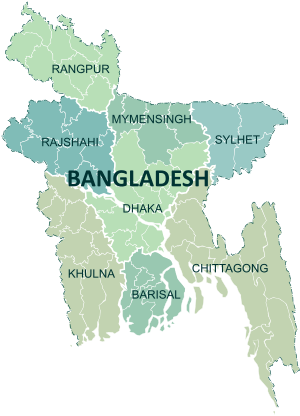 |
| Emblem |
 BANGLADESH
BANGLADESH(As on 13th May 2012)
Background:
Europeans began to set up trading posts in the area of Bangladesh in the 16th century; eventually the British came to dominate the region and it became part of British India. In 1947, West Pakistan and East Bengal (both primarily Muslim) separated from India (largely Hindu) and jointly became the new country of Pakistan. East Bengal became East Pakistan in 1955, but the awkward arrangement of a two-part country with its territorial units separated by 1,600 km left the Bengalis marginalized and dissatisfied. East Pakistan seceded from its union with West Pakistan in 1971 and was renamed Bangladesh. A military-backed, emergency caretaker regime suspended parliamentary elections planned for January 2007 in an effort to reform the political system and root out corruption. In contrast to the strikes and violent street rallies that had marked Bangladeshi politics in previous years, the parliamentary elections finally held in late December 2008 were mostly peaceful and Sheikh HASINA Wajed was elected prime minister. About a third of this extremely poor country floods annually during the monsoon rainy season, hampering economic development.
Geography : BANGLADESH
Location : Southern Asia, bordering the Bay of Bengal, between Burma and India
Geographic coordinates : 24 00 N, 90 00 E
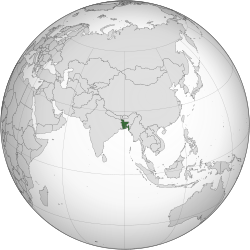 Map references: Asia
Map references: AsiaArea: Total: 143,998 sq km
Land: 130,168 sq km
Water: 13,830 sq km
Country comparison to the world: 95
Area-comparative : slightly smaller than Iowa
Land boundaries: Total: 4,246 km
Border countries: Burma 193 km,
India 4,053 km
Coastline: 580 km
Maritime claims:
Territorial sea: 12 nm
Contiguous zone: 18 nm
Exclusive economic zone: 200 nm
Continental shelf: up to the outer limits of the continental margin
Climate:
Tropical; mild winter (October to March); hot, humid summer (March to June); humid, warm rainy monsoon (June to October)
Terrain:
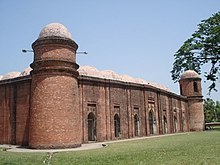 |
| Sixty Dome Mosque, Bagerhat |
Elevation extremes:
lowest point: Indian Ocean 0 m
highest point: Keokradong 1,230 m
Natural resources:
natural gas, arable land, timber, coal
Land use:
Arable land: 55.39%
 |
| Lalbag Fort |
Other: 41.53% (2005)
Irrigated land:
50,500 sq km (2008)
Total renewable water resources:
1,210.6 cu km (1999)
Freshwater withdrawal (domestic/industrial/agricultural):
Total: 79.4 cu km/yr (3%/1%/96%)
Per capita: 560 cu m/yr (2000)
Natural hazards:
Droughts; cyclones; much of the country routinely inundated during the summer monsoon season
Environment - current issues:
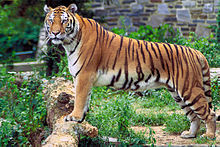 |
| Royal Bengal Tiger |
Environment - international agreements:
Party to: Biodiversity, Climate Change, Climate Change-Kyoto Protocol, Desertification, Endangered Species, Environmental Modification, Hazardous Wastes, Law of the Sea, Ozone Layer Protection, Ship Pollution, Wetlands
signed, but not ratified: none of the selected agreements
Geography - note:
most of the country is situated on deltas of large rivers flowing from the Himalayas: the Ganges unites with the Jamuna (main channel of the Brahmaputra) and later joins the Meghna to eventually empty into the Bay of Bengal
 |
| Sundarban Forest |
People and Society ::BANGLADESH
Nationality:
noun: Bangladeshi(s)
adjective: Bangladeshi
Ethnic groups:
Bengali 98%, other 2% (includes tribal groups, non-Bengali Muslims) (1998)
Languages: Bangla (official, also known as Bengali), English
 |
| Language Martyr's Monument |
Population: 161,083,804 (July 2012 est.)
Country comparison to the world: 8
Age structure:
0-14 years: 34.3% (male 27,551,594/female 26,776,647)
15-64 years: 61.1% (male 45,956,431/female 50,891,519)
65 years and over: 4.7% (male 3,616,225/female 3,778,119) (2011 est.)
Median age:
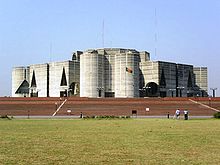 |
| National Parliament |
Male: 22.7 years
Female: 23.7 years (2011 est.)
Population growth rate:
1.579% (2012 est.)
Country comparison to the world: 73
Birth rate: 22.53 births/1,000 population (2012 est.)
Country comparison to the world: 73
Death rate: 5.71 deaths/1,000 population (July 2012 est.)
country comparison to the world: 173
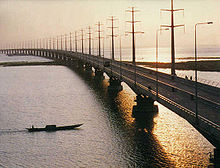 |
| Jamuna Bridge |
-1.04 migrant(s)/1,000 population (2012 est.)
country comparison to the world: 151
Urbanization:
urban population: 28% of total population (2010)
rate of urbanization: 3.1% annual rate of change (2010-15 est.)
Major cities - population:
DHAKA (capital) 14.251 million;
Chittagong 4.816 million;
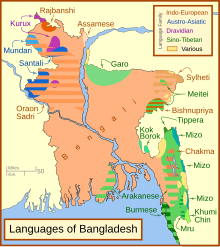 Khulna 1.636 million;
Khulna 1.636 million;Rajshahi 853,000 (2009)
Sex ratio:
at birth: 1.04 male(s)/female
under 15 years: 1.03 male(s)/female
15-64 years: 0.9 male(s)/female
65 years and over: 0.96 male(s)/female
total population: 0.95 male(s)/female (2012 est.)
Maternal mortality rate:
340 deaths/100,000 live births (2008)
country comparison to the world: 42
Infant mortality rate:
 |
| Ahsan Manjil |
country comparison to the world: 47
male: 51.48 deaths/1,000 live births
female: 46.39 deaths/1,000 live births (2012 est.)
Life expectancy at birth:
total population: 70.06 years
country comparison to the world: 147
male: 68.21 years
female: 71.98 years (2012 est.)
Total fertility rate:
 |
| Golden Temple, Bandarban |
country comparison to the world: 81
Health expenditures:
3.4% of GDP (2009)
country comparison to the world: 172
Physicians density:
0.295 physicians/1,000 population (2007)
Hospital bed density:
 |
| Paharpur Buddhist Monastery |
0.4 beds/1,000 population (2005)
Drinking water source:
improved:
urban: 85% of population
rural: 78% of population
total: 80% of population
unimproved:
urban: 15% of population
rural: 22% of population
total: 20% of population (2008)
| Hardinge Bridge |
improved:
urban: 56% of population
rural: 52% of population
total: 53% of population
unimproved:
urban: 44% of population
rural: 48% of population
total: 47% of population (2008)
 |
| Biman Bangladesh Airlines |
less than 0.1% (2009 est.)
country comparison to the world: 113
HIV/AIDS - people living with HIV/AIDS:
6,300 (2009 est.)
country comparison to the world: 116
HIV/AIDS - deaths:
fewer than 200 (2009 est.)
country comparison to the world: 101
Major infectious diseases:
degree of risk: high
food or waterborne diseases: bacterial and protozoal diarrhea, hepatitis A and E, and typhoid fever
vectorborne diseases: dengue fever and malaria are high risks in some locations
water contact disease: leptospirosis
animal contact disease: rabies
note: highly pathogenic H5N1 avian influenza has been identified in this country; it poses a negligible risk with extremely rare cases possible among US citizens who have close contact with birds (2009)
Children under the age of 5 years underweight:
 |
| Mazar of Hazrat Khan Zahan Ali |
41.3% (2007)
country comparison to the world: 3
Education expenditures:
2.4% of GDP (2008)
country comparison to the world: 148
Literacy:
definition: age 15 and over can read and write
total population: 47.9%
male: 54%
 |
| Mazar of Hazrat Shahjalal |
School life expectancy (primary to tertiary education):
total: 8 years
male: 8 years
female: 8 years (2007)
Unemployment, youth ages 15-24:
total: 9.3%
country comparison to the world: 106
male: 8%
female: 13.6% (2006)
 |
| Baitul Mukarram National Mosque |
Government :
Country name:
conventional long form: People's Republic of Bangladesh
conventional short form: Bangladesh
local long form: Gana Prajatantri Bangladesh
local short form:
former: East Bengal, East Pakistan
Government type:
parliamentary democracy
Capital:
name: Dhaka
geographic coordinates: 23 43 N, 90 24 E
time difference: UTC+6 (11 hours ahead of Washington, DC during Standard Time)
Administrative divisions:
7 divisions; Barisal, Chittagong, Dhaka, Khulna, Rajshahi, Rangpur, Sylhet
Independence:
16 December 1971 (from West Pakistan); note - 26 March 1971 is the date of independence from West Pakistan, 16 December 1971 is known as Victory Day and commemorates the official creation of the state of Bangladesh
National holiday:
Independence Day, 26 March (1971); note - 26 March 1971 is the date of independence from West Pakistan, 16 December 1971 is Victory Day and commemorates the official creation of the state of Bangladesh
Constitution:
enacted 4 November 1972; effective 16 December 1972; suspended following coup of 24 March 1982; restored 10 November 1986; amended many times
Legal system:
mixed legal system of mostly English common law and Islamic law
International law organization participation:
has not submitted an ICJ jurisdiction declaration; accepts ICCt jurisdiction
Suffrage:
18 years of age; universal
Executive branch:
chief of state: President Zillur RAHMAN (since 12 February 2009)
head of government: Prime Minister Sheikh HASINA Wajed (since 6 January 2009)
cabinet: Cabinet selected by the prime minister and appointed by the president
(For more information visit the World Leaders website )
elections: president elected by National Parliament for a five-year term (eligible for a second term); last election held on 11 February 2009 (next to be held in 2014)
election results: Zillur RAHMAN declared president-elect by the Election Commission on 11 February 2009 (sworn in on 12 February); he ran unopposed as president; percent of National Parliament vote - NA
Legislative branch:
unicameral National Parliament or Jatiya Sangsad; 300 seats (45 reserved for women) elected by popular vote from single territorial constituencies; members serve five-year terms
elections: last held on 29 December 2008; note - general elections must be held within 90 days of the expiration of the Parliament or by 29 March 2014 or earlier if Parliament is dissolved before its term expires
election results: percent of vote by party - AL 49%, BNP 33.2%, JP 7%, JIB 4.6%, other 6.2%; seats by party - AL 230, BNP 30, JP 27, JIB 2, other 11
Judicial branch:
Supreme Court (the chief justices and other judges are appointed by the president)
Political parties and leaders:
Awami League or AL [Sheikh HASINA]; Communist Party of Bangladesh or CPB [Manjurul A. KHAN]; Bangladesh Nationalist Party or BNP [Khaleda ZIA]; Bikalpa Dhara Bangladesh or BDB [Badrudozza CHOWDHURY]; Islami Oikya Jote or IOJ [multiple leaders]; Jamaat-e-Islami Bangladesh or JIB [Matiur Rahman NIZAMI]; Jatiya Party or JP (Ershad faction) [Hussain Mohammad ERSHAD]; Liberal Democratic Party or LDP [Oli AHMED]
Political pressure groups and leaders:
Flag description:
green field with a large red disk shifted slightly to the hoist side of center; the red disk represents the rising sun and the sacrifice to achieve independence; the green field symbolizes the lush vegetation of Bangladesh
National symbol(s):
Bengal tiger
National anthem:
name: "Amar Shonar Bangla" (My Golden Bengal)
lyrics/music: Rabindranath TAGORE
note: adopted 1971; Rabindranath TAGORE, a Nobel laureate, also wrote India's national anthem
Economy ::BANGLADESH
Economy - overview:
The economy has grown 5-6% per year since 1996 despite political instability, poor infrastructure, corruption, insufficient power supplies, and slow implementation of economic reforms. Bangladesh remains a poor, overpopulated, and inefficiently-governed nation. Although more than half of GDP is generated through the service sector, 45% of Bangladeshis are employed in the agriculture sector with rice as the single-most-important product. Bangladesh's growth was resilient during the 2008-09 global financial crisis and recession. Garment exports, totaling $12.3 billion in FY09 and remittances from overseas Bangladeshis, totaling $11 billion in FY10, accounted for almost 12% of GDP.
GDP (purchasing power parity):
$282.5 billion (2011 est.)
country comparison to the world: 44
$265.7 billion (2010 est.)
$249.8 billion (2009 est.)
note: data are in 2011 US dollars
GDP (official exchange rate):
$115 billion (2011 est.)
GDP - real growth rate:
6.3% (2011 est.)
country comparison to the world: 39
6.4% (2010 est.)
5.9% (2009 est.)
GDP - per capita (PPP):
$1,700 (2011 est.)
country comparison to the world: 194
$1,600 (2010 est.)
$1,500 (2009 est.)
note: data are in 2011 US dollars
GDP - composition by sector:
agriculture: 19.9%
industry: 30.4%
services: 49.7% (2011 est.)
Labor force:
75.42 million
country comparison to the world: 7
note: extensive export of labor to Saudi Arabia, Kuwait, UAE, Oman, Qatar, and Malaysia; workers' remittances were $10.9 billion in FY09/10 (2011 est.)
Labor force - by occupation:
agriculture: 45%
industry: 30%
services: 25% (2008)
Unemployment rate:
5% (2011 est.)
country comparison to the world: 48
5.1% (2010 est.)
note: about 40% of the population is underemployed; many participants in the labor force work only a few hours a week, at low wages
Population below poverty line:
31.5% (2010 est.)
Household income or consumption by percentage share:
lowest 10%: NA
highest 10%: 26.6% (2008 est.)
Distribution of family income - Gini index:
33.2 (2005)
country comparison to the world: 101
33.6 (1996)
Investment (gross fixed):
23.3% of GDP (2011 est.)
country comparison to the world: 82
Budget:
revenues: $12.67 billion
expenditures: $17.15 billion (2011 est.)
Taxes and other revenues:
11% of GDP (2011 est.)
country comparison to the world: 204
Budget surplus (+) or deficit (-):
-3.9% of GDP (2011 est.)
country comparison to the world: 125
Public debt:
36.7% of GDP (2011 est.)
country comparison to the world: 87
35.4% of GDP (2010 est.)
Inflation rate (consumer prices):
10.7% (2011 est.)
country comparison to the world: 194
8.1% (2010 est.)
Central bank discount rate:
5% (31 December 2010 est.)
country comparison to the world: 72
5% (31 December 2009 est.)
Commercial bank prime lending rate:
13.4% (31 December 2011 est.)
country comparison to the world: 66
13% (31 December 2010 est.)
Stock of narrow money:
$16.27 billion (31 December 2011 est.)
country comparison to the world: 67
$14.12 billion (31 December 2010 est.)
Stock of broad money:
$59.86 billion (30 October 2011 est.)
country comparison to the world: 64
$56.44 billion (31 December 2010 est.)
Stock of domestic credit:
$73.69 billion (31 December 2011 est.)
country comparison to the world: 58
$64.71 billion (31 December 2010 est.)
Market value of publicly traded shares:
$47 billion (31 December 2010)
country comparison to the world: 74
$7.068 billion (31 December 2009)
$6.671 billion (31 December 2008)
Agriculture - products:
rice, jute, tea, wheat, sugarcane, potatoes, tobacco, pulses, oilseeds, spices, fruit; beef, milk, poultry
Industries:
jute, cotton, garments, paper, leather, fertilizer, iron and steel, cement, petroleum products, tobacco, drugs and pharmaceuticals, ceramic, tea, salt, sugar, edible oil, soap and detergent, fabricated metal products, electricity and natural gas
Industrial production growth rate:
7.4% (2011 est.)
country comparison to the world: 35
Electricity - production:
25.62 billion kWh (2009 est.)
country comparison to the world: 66
Electricity - consumption:
23.94 billion kWh (2009 est.)
country comparison to the world: 65
Electricity - exports:
0 kWh (2009 est.)
Electricity - imports:
0 kWh (2009 est.)
Oil - production:
5,724 bbl/day (2010 est.)
country comparison to the world: 95
Oil - consumption:
98,000 bbl/day (2010 est.)
country comparison to the world: 75
Oil - exports:
2,770 bbl/day (2009 est.)
country comparison to the world: 108
Oil - imports:
77,340 bbl/day (2010 est.)
country comparison to the world: 77
Oil - proved reserves:
28 million bbl (1 January 2011 est.)
country comparison to the world: 83
Natural gas - production:
19.75 billion cu m (2009 est.)
country comparison to the world: 33
Natural gas - consumption:
20.1 billion cu m (2010 est.)
country comparison to the world: 35
Natural gas - exports:
0 cu m (2009 est.)
country comparison to the world: 61
Natural gas - imports:
0 cu m (2009 est.)
country comparison to the world: 158
Natural gas - proved reserves:
195.4 billion cu m (1 January 2011 est.)
country comparison to the world: 47
Current account balance:
-$372 million (2011 est.)
country comparison to the world: 99
$2.502 billion (2010 est.)
Exports:
$23.86 billion (2011 est.)
country comparison to the world: 69
$19.24 billion (2010 est.)
Exports - commodities:
garments, knitwear, agricultural products, frozen food (fish and seafood), jute and jute goods, leather
Exports - partners:
US 22.1%, Germany 14.1%, UK 8.5%, France 6.8%, Netherlands 6.1% (2010)
Imports:
$31.75 billion (2011 est.)
country comparison to the world: 63
$24.72 billion (2010 est.)
Imports - commodities:
machinery and equipment, chemicals, iron and steel, textiles, foodstuffs, petroleum products, cement
Imports - partners:
China 18.9%, India 12.7%, Singapore 6%, Malaysia 4.7%, Japan 4% (2010)
Reserves of foreign exchange and gold:
$10.98 billion (31 December 2011 est.)
country comparison to the world: 72
$11.18 billion (31 December 2010 est.)
Debt - external:
$24.93 billion (31 December 2011 est.)
country comparison to the world: 74
$24.6 billion (31 December 2010 est.)
Stock of direct foreign investment - at home:
$7.216 billion (31 December 2011 est.)
country comparison to the world: 84
$6.107 billion (31 December 2010 est.)
Stock of direct foreign investment - abroad:
$94.2 million (31 December 2011 est.)
country comparison to the world: 81
$91.2 million (31 December 2010 est.)
Exchange rates:
taka (BDT) per US dollar -
73.7 (2011 est.)
69.65 (2010 est.)
69.04 (2009)
68.554 (2008)
69.893 (2007)
Fiscal year:
1 July - 30 June
Communications ::BANGLADESH
Telephones - main lines in use:
900,000 (2010)
country comparison to the world: 83
Telephones - mobile cellular:
68.65 million (2010)
country comparison to the world: 18
Telephone system:
general assessment: inadequate for a modern country; introducing digital systems; trunk systems include VHF and UHF microwave radio relay links, and some fiber-optic cable in cities
domestic: fixed-line teledensity remains only about 1 per 100 persons; mobile-cellular telephone subscribership has been increasing rapidly and now exceeds 40 telephones per 100 persons
international: country code - 880; landing point for the SEA-ME-WE-4 fiber-optic submarine cable system that provides links to Europe, the Middle East, and Asia; satellite earth stations - 6; international radiotelephone communications and landline service to neighboring countries (2009)
Broadcast media:
state-owned Bangladesh Television (BTV) operates 1 terrestrial TV station, 3 radio networks, and about 10 local stations; 8 private satellite TV stations and 3 private radio stations also broadcasting; foreign satellite TV stations are gaining audience share in the large cities; several international radio broadcasters are available (2007)
Internet country code: .bd
Internet hosts: 69,285 (2011)
country comparison to the world: 87
Internet users: 617,300 (2009)
country comparison to the world: 112
Transportation ::BANGLADESH
Airports: 17 (2010)
country comparison to the world: 142
Airports - with paved runways:
total: 15
over 3,047 m: 2
2,438 to 3,047 m: 2
1,524 to 2,437 m: 6
914 to 1,523 m: 1
under 914 m: 4 (2010)
Airports - with unpaved runways:
total: 2
1,524 to 2,437 m: 1
under 914 m: 1 (2010)
Pipelines:
gas 2,714 km (2010)
Railways:
total: 2,622 km
country comparison to the world: 64
broad gauge: 946 km 1.676-m gauge
narrow gauge: 1,676 km 1.000-m gauge (2010)
Roadways:
total: 239,226 km
country comparison to the world: 21
paved: 22,726 km
unpaved: 216,500 km (2003)
Waterways:
8,370 km (includes up to 3,060 km of main cargo routes; the network is reduced to 5,200 km in the dry season) (2007)
country comparison to the world: 17
Merchant marine:
total: 62
country comparison to the world: 64
by type: bulk carrier 25, cargo 28, chemical tanker 1, container 5, petroleum tanker 3
foreign-owned: 8 (China 1, Singapore 7)
registered in other countries: 10 (Comoros 1, Hong Kong 1, Panama 5, Saint Vincent and the Grenadines 1, Sierra Leone 1, Singapore 1) (2011)
Ports and terminals:
Chittagong, Mongla Port
Transportation - note:
the International Maritime Bureau reports the territorial waters of Bangladesh remain a high risk for armed robbery against ships; attacks against vessels increased in 2010 for the second consecutive year; 23 commercial vessels were attacked both at anchor and while underway; crews were robbed and stores or cargoes stolen
Military ::BANGLADESH
Military branches:
Bangladesh Defense Force: Bangladesh Army (Sena Bahini), Bangladesh Navy (Noh Bahini, BN), Bangladesh Air Force (Biman Bahini, BAF) (2010)
Military service age and obligation:
16 years of age for voluntary enlisted military service (Air Force); 17 years of age (Army and Navy); conscription is by law possible in times of emergency, but has never been implemented (2010)
Manpower available for military service:
males age 16-49: 36,520,491 (2010 est.)
Manpower fit for military service:
males age 16-49: 30,486,086
females age 16-49: 35,616,093 (2010 est.)
Manpower reaching militarily significant age annually:
male: 1,606,963
female: 1,689,442 (2010 est.)
Military expenditures:
1.3% of GDP (2009)
country comparison to the world: 109
Here you can find some important link to know Bangladesh.
For any further requirement, please feel free to Contact Us .
BANGLADESH
(The National Web Portal)
BGMEA
(Bangladesh Garments Manufacturer & Exporters Association)
BKMEA
(Bangladesh Knitwear Manufacturer & Exporters Association)
BANGLADESH BANK
(The Central bank)
PARJATAN
Wikipedia
Virtual Bangladesh
